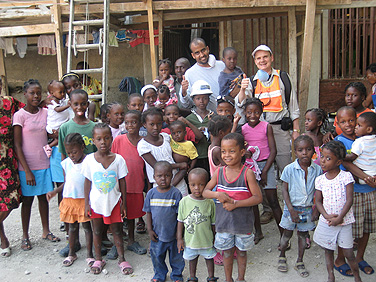News
Filiatrault talk opens summer series

Andre Filiatrault (rear right, with orange vest) spent eight days in Port-au-Prince after the earthquake, leading a team of French-speaking engineers in assessing the safety of buildings still standing after the quake.
In the days following the January earthquake that killed as many as 300,000 people in Haiti, UB faculty member Andre Filiatrault observed the devastation that filled the streets of the capital, Port-au-Prince.
Heaps of rubble—smashed concrete and twisted steel—rose where homes and shops once stood. In the suburb of Delmas, a giant roof slab dangled, nearly vertical, off the side of a school building, supported only by a few bent rebars.
Filiatrault, director of MCEER, UB’s earthquake engineering and extreme events research center, was leading a group of structural engineers and architects in assessing the safety of standing facilities. Blocks away from deserted hospitals the team cleared for use, Filiatrault would encounter surgeons operating outdoors, with intravenous lines hanging from the limbs of trees. In this way, fear lingered, manifesting itself in jarring sights: a doctor treating patients under the sun, an empty hospital building ready for use. People were still scared to go indoors.
How did this happen? The extent of the destruction is almost unimaginable. The magnitude 7.0 earthquake on Jan. 12 collapsed or severely damaged about 280,000 structures, including 13 of 15 government buildings. What went wrong, and what could be done to prevent a disaster from taking so many lives again?
These were the topics Filiatrault, a professor of civil, structural and environmental engineering, discussed on Wednesday with an audience of about 75 people in the Natural Sciences Complex, North Campus. His talk kicked off the 2010 UBThisSummer Lecture Series, which is open to the public and takes place on most Wednesdays, through July 28.
Filiatrault explained that Haiti was not prepared for the earthquake for a variety of reasons, which included lax enforcement of construction laws and the lack of a building code setting minimum standards. Engineers did not need a license to practice in the country and generally knew little about seismic design.
In overcrowded Port-au-Prince, the construction market was a "free for all," Filiatrault said, showing a photograph of informally planned homes blanketing a hillside. Builders poured concrete around rebars without ribs to keep the finished concrete from slipping. Residents constructed houses with unreinforced masonry, laying bricks without reinforcing them with steel bars. Such structures can withstand vertical loads, but topple during shaking.
From a technical standpoint, Filiatrault said, the Haiti disaster was not intriguing: Engineers know why damage was so widespread. The challenge now is to rebuild for the future. As he reminded a group of Haitian engineers at a seminar last week, a 9.5 magnitude earthquake served as a wake-up call for Chile in 1960, encouraging that nation to implement and enforce new seismic design requirements that likely saved many lives this February, when a magnitude 8.8 quake struck. The more recent earthquake killed fewer than 1,000 people.
"Hopefully," Filiatrault said, "the Jan. 12 event will also be a turning point for (Haiti)."
Besides Filiatrault’s January mission to Haiti, during which he and his team not only gauged the safety of standing structures, but also set up a protocol for continued assessments for the United Nations, Filiatrault and MCEER are contributing to Haiti’s rebuilding through education.
Last week, Filiatrault and Pierre Fouché, a UB doctoral candidate studying earthquake engineering, presented information on fundamentals of earthquake engineering to more than 200 Haitian engineers and other professionals gathered in Port-au-Prince for the first Earthquake Engineering Educational Seminar, a joint program of MCEER and Université Quisqueya.
In Haiti, Filiatrault told his UB audience, the rainy season has just begun, creating more hardship in a country already coping with a terrible toll. In the capital, men and women have been organizing rubble into piles, using their hands and wheelbarrows to haul the trash. They hope that someone will remove the debris, but no one does. When the rain comes, the streams of water that rush through the city leave the garbage strewn about once again.
In this and other ways, the pace of the relief and recovery effort can be frustratingly slow. But nevertheless, Filiatrault believes the future holds promise. The evidence is, once again, in the streets. The resilience of the Haitian people, Filiatrault said, is astonishing.
"I was there for about eight days after the earthquake and I never felt unsafe...You notice the people on the streets, people trying to go about their lives," Filiatrault said. "They were clean, they were well-dressed, they were selling things on the corner of the streets."

Reader Comments